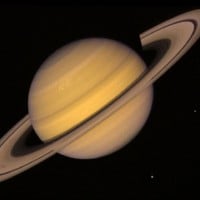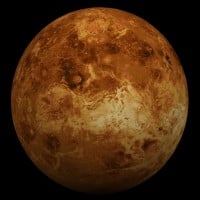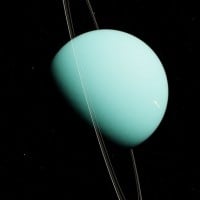Top Ten Planets That Would Look the Best If They Replaced Our Moon In the Sky
 Saturn is the 6th planet from the Sun, it is the second-largest and has the most moons. One year on Saturn is 29 Earth years (10,756 Earth days). Saturn is known for its rings. Saturn is a gas giant, so there is no solid surface on the planet. It is also almost 1 billion miles away from the Sun. The Cassini-Huygens spacecraft was sent to Saturn on October 15, 1997, and arrived at Saturn on July 1, 2004. Saturn was discovered in 1610 by Galileo Galilei.
Saturn is the 6th planet from the Sun, it is the second-largest and has the most moons. One year on Saturn is 29 Earth years (10,756 Earth days). Saturn is known for its rings. Saturn is a gas giant, so there is no solid surface on the planet. It is also almost 1 billion miles away from the Sun. The Cassini-Huygens spacecraft was sent to Saturn on October 15, 1997, and arrived at Saturn on July 1, 2004. Saturn was discovered in 1610 by Galileo Galilei. Saturn is 83.7 times larger than our earth. So if Saturn was put in the same place as the moon, it would look like we were right next to it.
That would actually look really cool.
Jupiter would look nice if we could see it in the night sky, but it would have to be at a greater distance from Earth. Also, we'd be orbiting it, not vice versa.
Jupiter is largely made up of hydrogen and helium, so that could affect our planet. As if one ball of gas in the sky wasn't enough!
Jupiter would pretty much take up the entire sky due to hoe giant it is.
Mars has a very similar surface to the moon, very dry and boring.
I've seen what Neptune looks like on the surface (I don't know if the pictures are fake or not) but either way it looks pretty. I love Neptune.
Neptune is really cold. So is would make earth colder. This isn't a good idea.
 Venus is the second planet from the Sun and the closest planetary neighbor to Earth. Known for its bright appearance in the sky, Venus is sometimes referred to as the "Evening Star" or the "Morning Star." The planet has a thick atmosphere primarily composed of carbon dioxide, leading to a greenhouse effect that makes it the hottest planet in our solar system. Surface conditions on Venus are extremely harsh, with temperatures high enough to melt lead and atmospheric pressure far greater than that on Earth.
Venus is the second planet from the Sun and the closest planetary neighbor to Earth. Known for its bright appearance in the sky, Venus is sometimes referred to as the "Evening Star" or the "Morning Star." The planet has a thick atmosphere primarily composed of carbon dioxide, leading to a greenhouse effect that makes it the hottest planet in our solar system. Surface conditions on Venus are extremely harsh, with temperatures high enough to melt lead and atmospheric pressure far greater than that on Earth. All this week I've been seeing Venus in the sky.
Mercury has a thin atmosphere, so we could travel there easily.
This would definitely work out.
 Uranus is the seventh planet from the Sun in our solar system. It was discovered by William Herschel in 1781, making it the first planet to be discovered with a telescope. Unique among the planets, Uranus has an axial tilt of about 98 degrees, causing it to rotate on its side. Composed mainly of hydrogen, helium, and a small amount of methane, the planet is known for its pale blue color due to the methane in its atmosphere.
Uranus is the seventh planet from the Sun in our solar system. It was discovered by William Herschel in 1781, making it the first planet to be discovered with a telescope. Unique among the planets, Uranus has an axial tilt of about 98 degrees, causing it to rotate on its side. Composed mainly of hydrogen, helium, and a small amount of methane, the planet is known for its pale blue color due to the methane in its atmosphere. It was only a matter of time before this was added.